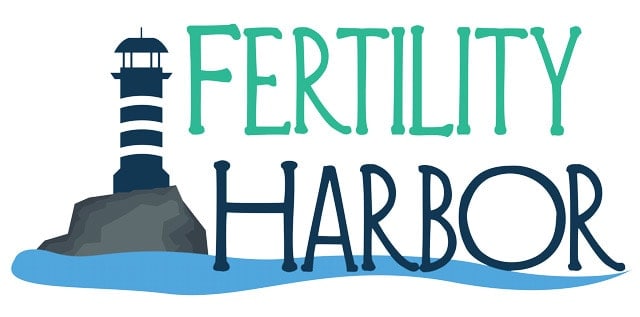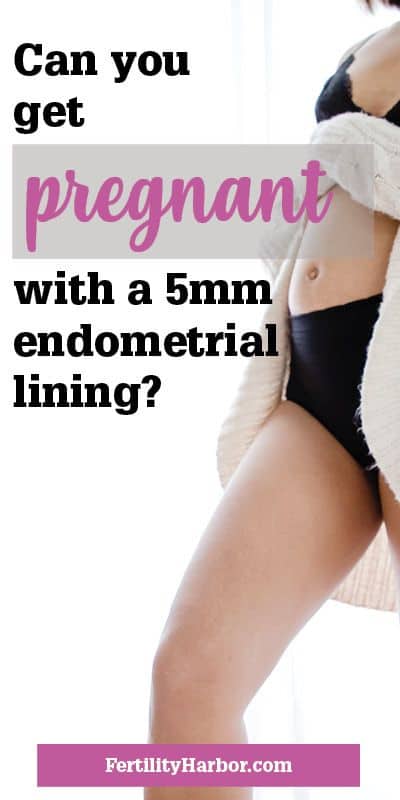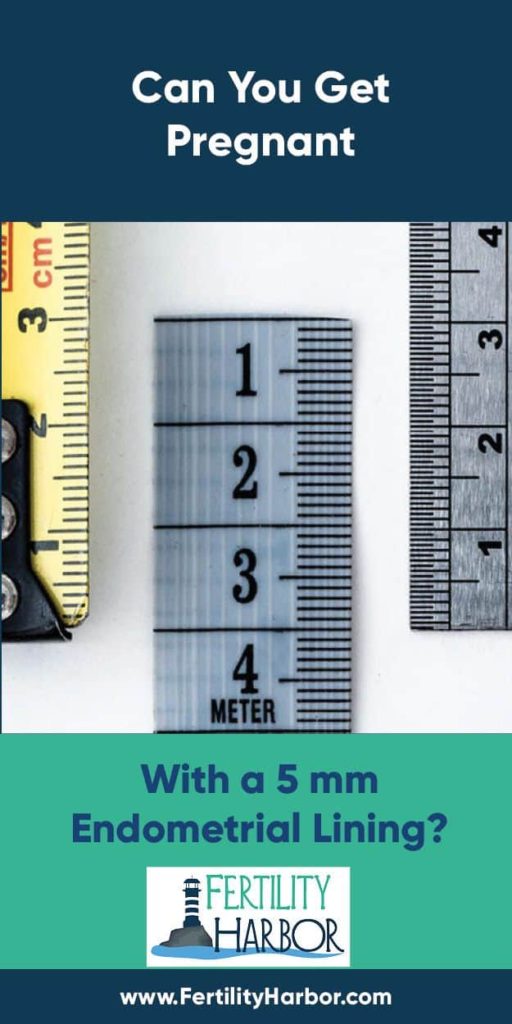This post was reviewed for medical accuracy by Rosalie Gunson, a Certified Registered Nurse Practitioner specializing in fertility care.
The endometrial lining is one of those things that most women who’ve had normal, spontaneous pregnancies probably never think about. But the thickness of the lining can be the difference between a positive test and a negative one, so it pays for us infertile women to pay attention to it.
A 5 mm endometrial lining at the time of hCG trigger or IVF transfer is probably too thin for an embryo to implant and develop. Most fertility clinics consider 8 mm to be the minimum endometrial thickness for a good chance of conception.
If you’ve been told your endometrial lining is thin, don’t lose hope! Talk to your doctor or fertility specialist about possible ways to increase that lining, such as taking estrogen.
What is the endometrial lining?
The endometrial lining is the innermost lining of your uterus. In the first part of your cycle, before ovulation, the lining gets thicker to prepare for a possible pregnancy.
For example, these are typical measurements during a cycle:
- During your period: 2-4 mm
- Follicular phase: 5-11 mm
- Ovulation: Up to 16 mm
A potential fetus needs a fresh uterine lining in order to grow. If you’ve ovulated but you’re not pregnant, your body will shed the lining that wasn’t needed. You know this as your period.
Why is the endometrial lining important for pregnancy?
A healthy endometrial lining is very important for a successful pregnancy. You’re not really pregnant until implantation, when the fertilized egg attaches to the uterus. The lining should be nice and thick to allow that fertilized egg to borrow in.
You may have heard of the phenomenon of implantation bleeding. That’s a little spotting that some women (but not all, or even most!) experience when implantation occurs. For further info, see Can You Get a BFP Without Implantation Bleeding?
Once implantation occurs and you’re officially pregnant, the lining will stay thick. Its main job is to nourish the fetus until the placenta develops.
How is the endometrial lining measured?
Obviously, you can’t measure the uterine lining from the outside. It’s measured using transvaginal ultrasound.
This is the same method that your fertility team will use to measure growing follicles or a developing fetus in early pregnancy. (Unfamiliar with these ultrasounds? Check out my post Do Transvaginal Ultrasounds Hurt?)
Your fertility team may also look for a “trilaminar” lining on the scan before you do your HcG trigger or transfer. If they can see three layers — sort of like a feather, or the hamburger icon on a website — it’s a promising sign.
What is considered a good endometrial lining for conceiving?
What exactly is considered a good endometrial lining may vary a bit depending on your doctor’s judgement and what type of treatment you are doing.
If you’re doing something besides IVF — such as an IUI or timed intercourse — an endometrial lining of 6 mm or 7 mm may be considered good enough to trigger ovulation.
But IVF is much more involved and expensive, so doctors may not recommend proceeding with the cycle unless it’s as promising as possible. They may insist on a minimum lining of 8 mm or even 9 mm before going ahead with a transfer.
If you’re planning a frozen embryo transfer (FET) and your lining is too thin (under 8 mm), you can delay the actual transfer until your lining is optimal. For more info on FETs, see the post Should You Do a FET if You Are Sick?
What can you do to get a thicker endometrial lining?
Increase estrogen
In the first part of your cycle, follicles are growing and secreting estrogen, which causes the lining to thicken. So it makes sense that a common reason for a thin endometrial lining is low estrogen.
Women with a low BMI or low body fat tend to have lower estrogen levels, so if that’s your situation, gaining weight may help. (Fat cells secrete estrogen!) For some women that may involve getting treatment for an underlying eating disorder, such as anorexia.
If your endometrial lining tends to be thin and you’re already at a healthy weight, your doctor may prescribe estrogen supplements. You will take estrogen in the first half of the next cycle to see if that will help your uterine lining thicken.
When I was doing fertility treatment, my ultrasounds showed that my uterine lining was not great. Sometimes it would even get thinner during the first half of my cycle, which isn’t supposed to happen.
Once my doctors identified this pattern, I took estrogen supplements for the first half of the cycle. It made a big difference! I got pregnant with my twins on cycle #7, which was the first cycle I’d ever had a lining of 10 mm.
Other issues besides low estrogen
But not everyone with a thin lining has low estrogen. There may be other issues, such as uterine fibroids. Getting an HSG may help find these problems so they can be resolved before undergoing more intensive fertility treatment. For more about the HSG test, read Does an HSG Hurt? What to Expect.
Unfortunately, some fertility medications can make your lining thinner. Repeated use of Clomid has been shown to thin the lining, which is one reason my doctor never had me take Clomid. A thinner lining was the last thing I needed!
Instead, I did 5 cycles of letrozole/ Femara and then moved on to Follistim injections. For further info on this progression, check out When to Consider Moving on to Injectable Fertility Meds.
A good endometrial lining also requires a good blood supply, so you may find that a little moderate exercise helps get the blood pumping. Yoga, swimming, and Zumba are all fun options that aren’t too intense.
Can your endometrial lining be too thick?
So you need a nice thick lining for that fertilized egg to burrow into, but you may be wondering if it’s possible for your lining to be too thick. The answer is… maybe.
A typical uterine lining is roughly 8 mm to 14 mm at the time of trigger or transfer. But studies have suggested that it’s better to have a thick lining (over 14 mm) than a thin one (under 8 mm) when it comes to implantation.
One caveat: If your uterine lining is “too thick” at the very beginning of the cycle, before you have taken any stimulation drugs, it is possible that your cycle will be cancelled. Fertility doctors may worry that your lining is thick because it’s old. More info on cancelled cycles can be found here.
If your uterine lining is deemed to be too thick for IVF but your follicles are promising, you may have the option of freezing eggs for future use.
Long-term implications of a thick endometrial lining
Given that low estrogen can cause a thin lining, it follows that high estrogen can cause a thick lining.
Women can get a condition called endometrial hyperplasia when their estrogen is high but progesterone is low. Their lining keeps building up, even though they’re not ovulating or getting a period.
Endometrial hyperplasia is usually not a concern for women doing fertility treatment because they’re taking medications to supercharge their ovaries and induce ovulation. Endometrial hyperplasia is most common in women close to menopause.
If your lining stays too thick for too long, it can put you at risk for developing uterine cancer. That is one reason that regular periods are important for overall health, even for women who have no intention of becoming pregnant soon (or ever!). For more info, see my post Should Regular Periods Be Considered a Vital Sign?
Women who have not had a period in a long time and aren’t pregnant may be prescribed Provera, a synthetic form of progesterone, to cause the lining to shed and jump-start a new cycle. That will keep the endometrial lining from building up too much. More info on taking Provera can be found here.
The role of progesterone
Speaking of Provera… Remember that it’s the drop in progesterone, not progesterone itself, that causes you to get your period. In a healthy pregnancy, progesterone doesn’t drop. It stays high, and the uterine lining isn’t shed.
For some women, unfortunately, low progesterone is associated with bleeding and early pregnancy loss. That’s why many fertility clinics will have patients take progesterone in the second half of the cycle.
This may take the form of capsules (which can be taken orally or vaginally), vaginal suppositories or gels, or intramuscular injections (usually in the butt cheeks — sorry!).
Once they get their BFP, these patients typically continue with the progesterone until the first trimester is over. At that point, the pregnancy will be well-established and the placenta will have taken over progesterone production.
Conclusion
A 5 mm uterine lining at ovulation probably isn’t thick enough to support implantation and a healthy pregnancy, but there are steps you can take to increase your lining in the cycle.
As always, don’t be afraid to discuss your concerns with your fertility team!
This post was last updated in March 2025. Most of its content was written before 2020.




 I’m Jenn! Here I am with my beautiful twin boys. My pregnancy was possible thanks to fertility treatment for PCOS.
I’m Jenn! Here I am with my beautiful twin boys. My pregnancy was possible thanks to fertility treatment for PCOS.


